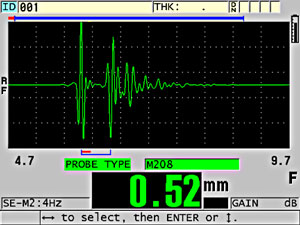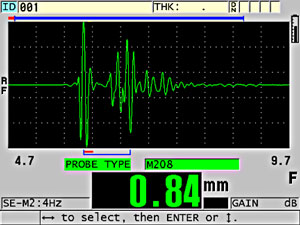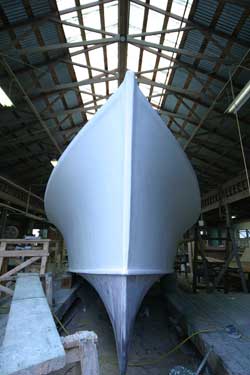Overview of Fiberglass Gelcoat Thickness InspectionsGelcoat is a hard polyester resin coating that is applied over structural fiberglass. It provides a smooth, glossy protective surface that eliminates friction and improves appearance. It is commonly used on fiberglass boat hulls and on bathroom fixtures such as sinks, tubs, and shower stalls. Manufacturers of fiberglass products need to measure gelcoat thickness to confirm that it is within a specified range. In particular, it is important to detect where the gelcoat is too thin because of insufficient application or shrinkage. Measurements typically involve a range of about 0.25 to 1 mm (0.01 to 0.04 in.), with most cases involving a nominal thickness of around 0.5 mm (0.02 in.) Gelcoat Thickness Gauging EquipmentGelcoat thickness can be measured with our precision thickness gauges, such as the 39DL PLUS™ and 45MG gauges with the Single Element software option. The waveform display that is standard on the 39DL PLUS gauge and available on the 45MG gauge as an option is useful for establishing echo quality and verifying readings. |
Gelcoat is normally measured with a delay line transducer. The most commonly recommended transducer is the M208-RM (20 MHz, 0.125 in. element diameter). In cases involving thick gelcoat, the M202-RM transducer (10 MHz, 0.25 in. element diameter) can also be used.
Procedure to Measure Gelcoat Thickness on Fiberglass
This application is set up as a Mode 2 measurement (interface echo to first backwall echo). The primary challenge is that the inside surface of gelcoat is usually rough and irregular, conforming to the surface profile of the fiberglass. Due to this nonuniform geometry, the quality of the echo from the gelcoat/fiberglass boundary often varies widely from point to point. The first echo from that boundary may not be the largest and phase distortion may appear to invert echoes. In some cases, roughness may drop reflected echo amplitude below the detectable minimum. Also, the gelcoat/fiberglass boundary echo is usually followed by several other peaks representing scatter noise from within the underlying fiberglass, which if detected will cause erroneously high readings.
Because manufacturers are usually most concerned about confirming that gelcoat meets a minimum thickness specification, the recommended procedure is to make several readings within a small area and record the minimum reading obtained. If a waveform display is available, then it is possible to verify whether the first returning echo (representing minimum gelcoat thickness) is being detected by monitoring the waveform display as seen in the screen images below.
If a 45MG gauge is used without the waveform display option, it is particularly important to note the minimum reading within a local area. Any abrupt transition to a higher reading usually represents false detection caused by irregular echoes. As a general rule, the gauge gain should be set high to maximize the likelihood of detecting the first returning echo. The First Peak detection mode that is available on most of our gauge models is also useful in this application to help ensure
measurement of minimum thickness.

Example of an optimal gelcoat reading. The first peak is detected.

Example of an inaccurate reading. The first peak is undetected due to low amplitude related to inside surface roughness.
Measuring Total Fiberglass Thickness
In many cases, the same gauge that is used for gelcoat measurement can also be used to measure total wall thickness (gelcoat plus fiberglass) using a second transducer, usually an M1036 (2.25 MHz, 0.5 in. element diameter, high sensitivity). The maximum measurable fiberglass thickness is typically about 12.5 mm (0.5 in.). For thicker fiberglass, a high-penetration (HP) gauge is usually required.
 This application note explains how to measure the thickness of gelcoat over fiberglass.
This application note explains how to measure the thickness of gelcoat over fiberglass.



